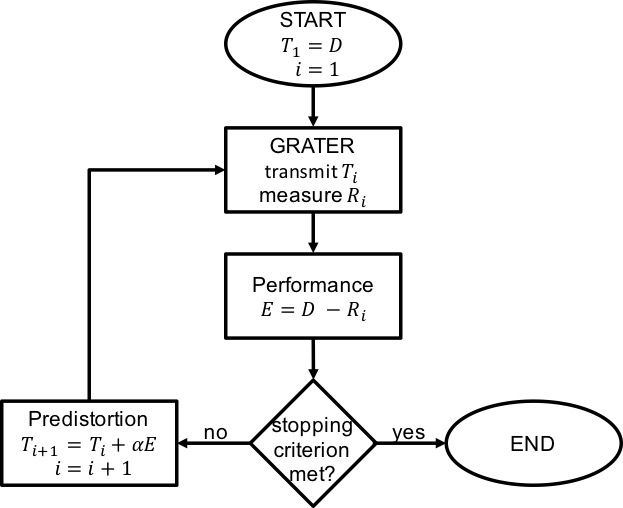0921
GRATER-based RF pulse predistortion improves multiband bSSFP imaging1Biomedical Engineering, University of Southern California, Los Angeles, CA, United States, 2Electrical Engineering, University of Southern California, Los Angeles, CA, United States
Synopsis
We present a hardware-free way to mitigate RF envelope error that has the potential to be extremely fast (<1 min), and to benefit simultaneous multislice (SMS) balanced steady-state free precession (bSSFP) imaging. This approach improves RF waveform fidelity 9-fold in a variety of multiband pulses, and correspondingly reduces bSSFP spurious side-lobe excitation 3-fold. This provides 4-fold reduction in SMS bSSFP side-lobe signal.
Purpose
Simultaneous multislice bSSFP imaging is hindered by RF transmit imperfection, where off-resonant low flip-angles of spuriously excited side-lobes will experience high signal excitation and produce artifacts in reconstructed images. Iterative GRATER-based predistortion is demonstrated to improve 4-band bSSFP imaging in the presence of off-resonance.Methods
Experiments were performed on a clinical 3T MRI Scanner (HD23, GE Healthcare, Waukesha, WI). GRATER measurements were obtained with the body coil, centered about a 40x10x10 cm3 rectangular phantom. The scanner was loaded with 280 lbs.
Predistortion Technique
RF excitation was improved by correcting for expected errors in transmitted waveforms. An overview of iterative GRATER-based predistortion is given in Figure 1. GRATER measurements were performed with transmit and sampling period of 2μs. The readout gradient amplitude was half of the negative slice-select gradient amplitude. Twice the number of RF resolution points were acquired and then decimated. One measurement was taken and OVS was not used. The waveform was corrected for off-resonance, T2* decay, time-shift, scaling, and initial phase angle calculated during the first iteration. Scaling and time-shift were calculated and updated each iteration [1].
Evaluation of RF Waveforms
Final predistorted waveforms were produced after 12 iterations of GRATER-based predistortion and damping factor α=0.25. The technique was used on multiband pulses with MB=3-5 RF pulses with slice thicknesses of 5 and 10 mm. These pulses were designed using the Shinnar-Le Roux algorithm [2] with 648 μs duration, 324 point resolution, 30° FA, 2 cm center-to-center spacing, and optimized phase scheduling [3].
Quality of predistortion was assessed using normalized root mean square error (NRMSE) between desired and measured waveforms. Improvement in excitation was validated with slice profile measurements. Slice profiles were evaluated with 2 metrics: max side-lobe signal and mean signal from the largest side-lobe. The slice profile was obtained by acquiring multiple GRATER measurements with phase-encoding along x and y, taking the inverse Fourier transform, and discarding signal except at the center of the phantom to obtain a frequency profile along an area with uniform signal.
Evaluation of SMS performance
A phantom of ABS bricks (LEGO) with a different pattern every 2 cm deep was submerged in water and imaged to indicate aliased signal from extra excited slices. The phantom was imaged with the same scanner loading as previous experiments. Fully-sampled 4-band bSSFP imaging was performed with 12 encoded slices using kz-gradient encoding [4]. Encoding was designed to obtain images with 2 cm spacing, centered around the 4-band pulse. This experiment was performed with and without predistorted waveforms to demonstrate differences in encoded side-lobe signal. The same 4-band experiment was repeated with an added z-shim to illustrate bSSFP imaging of off-resonant low FA side-lobes.
Results
The proposed iterative predistortion technique improved RF transmission over 12 iterations with α=0.25. Each iteration took ~30 seconds. In pulses with 3-5 bands and 5-10 mm thick slices, NRMSE is reduced from <30% to <3.1%. Corresponding max and mean of the largest spuriously excited side-lobes are reduced from <6.6% and <4.2% to <2.2% and <1.5%, respectively (Figure 2).
The slice profile of a 4-band pulse with 10 mm slice thickness is closer to the desired profile after predistortion (Figure 3). Before predistortion, spurious side-lobe signal has similar spacing and width as the main desired lobes. Side-lobe intensity is highest closest to the main lobes. After predistortion, stop-band ripple approaches that of the desired pulse, albeit at a higher signal intensity.
Reduction in side-lobe excitation is seen after predistortion in a phantom with fully-sampled 4-band multi-band bSSFP imaging and 12 encoded slices (Figure 4). Encoded spurious side-lobe signal about z=-5 cm was highest before predistortion and was reduced 3.8-fold after predistortion. After predistortion, signal encoded about z=5 cm contains features from reference slices +3 and+5 cm. This corresponds to the slice profile (Figure 3), where two small side-lobes are seen on either side of z=5 cm.
Off-resonant side-lobe excitation was also reduced after predistortion (Figure 5). The intensity of excited off-resonant signal was highest before predistortion in slices at z=-5 and -7 cm and was reduced 4.2 and 2.8-fold after predistortion, respectively. Residual signal contained features from multiple slices, corresponding to the slice profile (Figure 3), where multiple smaller side-lobes after predistortion replace a single side-lobe before predistortion.
Conclusion
Iterative GRATER-based predistortion improved multiband pulse performance with 9-fold reduction in NRMSE and 3-fold reduction in max side-lobe signal excitation. Predistorted waveforms reduced excitation artifacts with multiband bSSFP imaging. Future work will include exploration of appropriate stopping criterion and development of GRATER-based predistortion as part of prescan for in-vivo scans.Acknowledgements
Grant support: NIH #R01-HL130494References
[1] Landes VL, Nayak KS. Simple method for RF pulse measurement using gradient reversal. Magn. Reson. Med. 2018; 9:2642–2651.
[2] Cunningham CH, Wood ML. Method for improved multiband excitation profiles using the Shinnar-Le Roux transform. Magn Reson Med. 1999;42:577–584.
[3] Wong E. Optimized Phase Schedules for Minimizing Peak RF Power in Simultaneous Multi-Slice RF Excitation Pulses. Proc. 20th Annu. Meet. ISMRM, Melbourne, Aust. 2012;20:2209.
[4] Setsompop K, Gagoski BA, Polimeni JR, Witzel T, Wedeen VJ, Wald LL. Blipped-controlled aliasing in parallel imaging for simultaneous multislice echo planar imaging with reduced g-factor penalty. Magn. Reson. Med. 2012;67:1210–1224.
Figures




